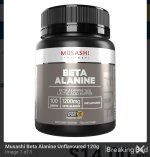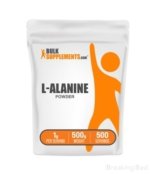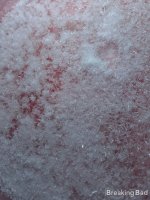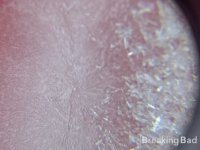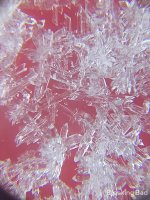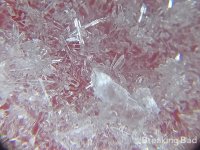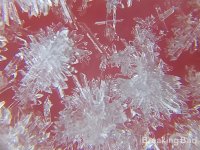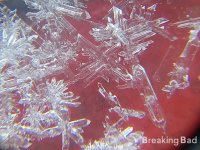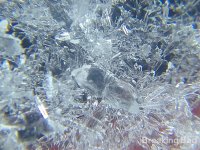G.Patton
Expert
- Joined
- Jul 5, 2021
- Messages
- 3,025
- Solutions
- 3
- Reaction score
- 3,425
- Points
- 113
- Deals
- 1
Introduction
The synthesis of phenylpropanolamine (PPA), a compound historically utilized as a decongestant and appetite suppressant, is of notable interest in the realm of organic and pharmaceutical chemistry. This article presents a meticulous synthesis pathway for phenylpropanolamine hydrochloride, encompassing essential procedural details to guide researchers through the process. This comprehensive guide aims to provide clarity and reproducibility for chemists focused on phenylpropanolamine (PPA), which can be used for amphetamine synthesis.
Phenylpropanolamine (PPA) Structure
Other names: PPA; Norephedrine; (1RS,2SR)-Phenylpropanolamine; dl-Norephedrine; (±)-Norephedrine; (1RS,2SR)-α-Methyl-β-hydroxyphenethylamine; (1RS,2SR)-β-Hydroxyamphetamine; CAS 14838-15-4;
Equipment and glassware:
- Pear shaped flask 50 mL;
- Reflux condenser;
- Funnel;
- Rotary evaporator;
- Vacuum pump;
- Buchner flask and funnel;
- Beakers 200 mL x2; 50 ml x3; 100 ml x3;
- Measuring cylinder 20 ml;
- Laboratory grade thermometer (20 °C to 200 °C) with flask adapter;
- Heating plate;
- Laboratory scale (0.1 g-100 g is suitable);
- Separating funnel 500 mL;
- Brine solution 200 mL;
Phenylpropanolamine (PPA) Hydrochloride Powder
Reagents:
- Alanine 8.6 g;
- DMSO;
- Acetic acid solution 5%, 103 mL;
- DCM 950 mL;
- Distilled water (H2O) 450 mL
- Sodium hydroxide 10% (NaOH) aqueous solution;
- Hydrochloric acid 35% aqueous;
- Petroleum ether 150 mL;
- Al2O3;
Procedures:
1. A mixture of alanine 8.6 g and benzaldehyde 12 mL in DMSO 10 mL was stirred and heated at 130°C for 1 hour in 50 ml pear shaped flask with reflux condenser.
2. Acetic acid solution 5%, 103 mL was added to the reaction mixture and refluxed.
3. After 4 hours, the mixture was allowed to cool to room temperature.
4. DCM 500 mL was added to the mixture and extracted with distilled water (H2O) 3 × 150 mL. DCM is discarded after extractions.
5. The pH of the aqueous phase was adjusted to 10 with 10% NaOH (aq) and extracted with 3 × 150 mL of fresh DCM.
6. The combined DCM extracts were washed with brine ~2 × 100 mL, decanted into a separate vessel from separatory funnel.
7. Washed extract was acidified by 35% aq HCl solution to pH 6, water layer is selarated.
8. Then, water layer washed with petroleum ether (or its analogue) 2 × 75 mL, Al2O3 is added.
9. Al2O3 is filtred after 1 hour through a paper filter.
10. Next, the mixture is evaporated with yielding phenylpropanolamine hydrochloride as a white, waxy solid.
Phenylpropanolamine hydrochloride should be dried over alkali in vacuum desiccator to get powder form.
2. Acetic acid solution 5%, 103 mL was added to the reaction mixture and refluxed.
3. After 4 hours, the mixture was allowed to cool to room temperature.
4. DCM 500 mL was added to the mixture and extracted with distilled water (H2O) 3 × 150 mL. DCM is discarded after extractions.
5. The pH of the aqueous phase was adjusted to 10 with 10% NaOH (aq) and extracted with 3 × 150 mL of fresh DCM.
6. The combined DCM extracts were washed with brine ~2 × 100 mL, decanted into a separate vessel from separatory funnel.
7. Washed extract was acidified by 35% aq HCl solution to pH 6, water layer is selarated.
8. Then, water layer washed with petroleum ether (or its analogue) 2 × 75 mL, Al2O3 is added.
9. Al2O3 is filtred after 1 hour through a paper filter.
10. Next, the mixture is evaporated with yielding phenylpropanolamine hydrochloride as a white, waxy solid.
Phenylpropanolamine hydrochloride should be dried over alkali in vacuum desiccator to get powder form.
Source
Doddridge, Alexandra, Michael Collins, and Helen Salouros. "Profiling ephedrine prepared from N‐methylalanine via the Akabori‐Momotani reaction." Drug Testing and Analysis 10.3 (2018): 548-556. https://analyticalsciencejournals.onlinelibrary.wiley.com/doi/abs/10.1002/dta.2239
Last edited:

